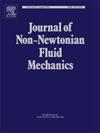Features and limitations of recent elastoviscoplastic constitutive models under Large Amplitude Oscillatory Shear (LAOS)
IF 2.7
2区 工程技术
Q2 MECHANICS
引用次数: 0
Abstract
Elastoviscoplastic (EVP) models are becoming more widely adopted to investigate the deformation and flow of yield stress materials for various applications. In this work, we investigate EVP models, primarily the Saramito model but also the recently developed Kamani–Donley–Rogers (KDR) model, under Large Amplitude Oscillatory Shear (LAOS) tests using Fourier Transform (FT) rheology, dissipation ratio () analysis and the Sequence of Physical Processes (SPP) framework. A detailed parametric study has been conducted for the Saramito model for a wide range of values of the relevant non-dimensional parameters – Bingham, Weissenberg and Deborah numbers. We also compare the Saramito and KDR models for a particular set of conditions and compare them with experimental data for Pluronic F127 hydrogel, a yield stress fluid commonly used in 3D printing. The parametric study of the Saramito model reveals a universal scaling for the onset of purely elastic behaviour, which shows dependence on both Bingham and Weissenberg numbers. Moreover, we demonstrate that although both EVP models can predict the ‘yielding’ process, the KDR model provides a better agreement with rheological data for Pluronic F127. The KDR also performs better in predicting associated EVP behaviour compared to the Saramito model, e.g. gradual change in the storage and loss moduli and the values near the onset of yielding. However, neither model could fully capture higher harmonics, shapes of the Lissajous-Bowditch curves and the intra-cycle rheological transitions when compared to experimental data. In addition to the LAOS measurements, further tests under different flow conditions of the recently-developed KDR model against experimental data for yield stress fluids are required to assess its capabilities in capturing the full spectrum of EVP behaviours.
近年来大振幅振荡剪切作用下弹粘塑性本构模型的特点与局限性
弹粘塑性(EVP)模型被越来越广泛地应用于研究屈服应力材料的变形和流动。在这项工作中,我们研究了EVP模型,主要是Saramito模型,以及最近开发的Kamani-Donley-Rogers (KDR)模型,在使用傅里叶变换(FT)流变学,耗散比(ϕ)分析和物理过程序列(SPP)框架的大振幅振荡剪切(LAOS)测试下。对Saramito模型进行了详细的参数化研究,研究了相关的非量纲参数- Bingham, Weissenberg和Deborah数字的广泛值。我们还比较了特定条件下的Saramito和KDR模型,并将它们与Pluronic F127水凝胶(3D打印中常用的屈服应力流体)的实验数据进行了比较。萨拉米托模型的参数化研究揭示了纯弹性行为开始的普遍尺度,它显示了宾汉姆和魏森伯格数的依赖性。此外,我们证明,尽管两种EVP模型都可以预测“屈服”过程,但KDR模型与Pluronic F127的流变学数据更吻合。与Saramito模型相比,KDR在预测相关EVP行为方面也表现更好,例如,在屈服开始附近的存储和损失模量以及ϕ值的逐渐变化。然而,与实验数据相比,这两个模型都不能完全捕获高次谐波、Lissajous-Bowditch曲线的形状和周期内流变转变。除了老挝的测量外,还需要根据屈服应力流体的实验数据,在不同流动条件下对最近开发的KDR模型进行进一步测试,以评估其捕获EVP全谱行为的能力。
本文章由计算机程序翻译,如有差异,请以英文原文为准。
求助全文
约1分钟内获得全文
求助全文
来源期刊
CiteScore
5.00
自引率
19.40%
发文量
109
审稿时长
61 days
期刊介绍:
The Journal of Non-Newtonian Fluid Mechanics publishes research on flowing soft matter systems. Submissions in all areas of flowing complex fluids are welcomed, including polymer melts and solutions, suspensions, colloids, surfactant solutions, biological fluids, gels, liquid crystals and granular materials. Flow problems relevant to microfluidics, lab-on-a-chip, nanofluidics, biological flows, geophysical flows, industrial processes and other applications are of interest.
Subjects considered suitable for the journal include the following (not necessarily in order of importance):
Theoretical, computational and experimental studies of naturally or technologically relevant flow problems where the non-Newtonian nature of the fluid is important in determining the character of the flow. We seek in particular studies that lend mechanistic insight into flow behavior in complex fluids or highlight flow phenomena unique to complex fluids. Examples include
Instabilities, unsteady and turbulent or chaotic flow characteristics in non-Newtonian fluids,
Multiphase flows involving complex fluids,
Problems involving transport phenomena such as heat and mass transfer and mixing, to the extent that the non-Newtonian flow behavior is central to the transport phenomena,
Novel flow situations that suggest the need for further theoretical study,
Practical situations of flow that are in need of systematic theoretical and experimental research. Such issues and developments commonly arise, for example, in the polymer processing, petroleum, pharmaceutical, biomedical and consumer product industries.

 求助内容:
求助内容: 应助结果提醒方式:
应助结果提醒方式:


